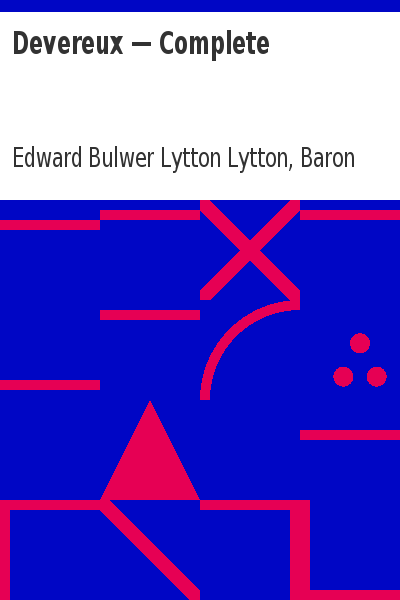
The Last Days of Pompeii
Baron Edward Bulwer Lytton Lytton
Subjects: Historical fiction, PR, Pompeii (Extinct city) -- Fiction, I
Downloads: 660

Subjects: Historical fiction, PR, Pompeii (Extinct city) -- Fiction, I
Downloads: 660
The Last Days of Pompeii is a novel written by the baron Edward Bulwer-Lytton in 1834. The novel was inspired by the painting The Last Day of Pompeii by the Russian painter Karl Briullov, which Bulwer-Lytton had seen in Milan. It culminates in the cataclysmic destruction of the city of Pompeii by the eruption of Mount Vesuvius in AD 79. The novel uses its characters to contrast the decadent culture of 1st-century Rome with both older cultures and coming trends. The protagonist, Glaucus, represents the Greeks who have been subordinated by Rome, and his nemesis Arbaces the still older culture of Egypt. Olinthus is the chief representative of the nascent Christian religion, which is presented favourably but not uncritically. The Witch of Vesuvius, though she has no supernatural powers, shows Bulwer-Lytton's interest in the occult – a theme which would emerge in his later writing, particularly The Coming Race. A popular sculpture by American sculptor Randolph Rogers, Nydia, the Blind Flower Girl of Pompeii (1856), was based on a character from the book. From Wikipedia (CC BY-SA).

Alice, or the Mysteries — Book 01

Alice, or the Mysteries — Book 02

Alice, or the Mysteries — Book 03

Alice, or the Mysteries — Book 04

Alice, or the Mysteries — Book 05

Alice, or the Mysteries — Book 06

Alice, or the Mysteries — Book 07

Alice, or the Mysteries — Book 08

Alice, or the Mysteries — Book 09

Alice, or the Mysteries — Book 10

Alice, or the Mysteries — Book 11

Alice, or the Mysteries — Complete

A Strange Story — Complete

A Strange Story — Volume 01

A Strange Story — Volume 02

A Strange Story — Volume 03

A Strange Story — Volume 04

A Strange Story — Volume 05

A Strange Story — Volume 06

A Strange Story — Volume 07

A Strange Story — Volume 08

Athens: Its Rise and Fall, Book I

Athens: Its Rise and Fall, Book II

Athens: Its Rise and Fall, Book III

Athens: Its Rise and Fall, Book IV

Athens: Its Rise and Fall, Book V

Athens: Its Rise and Fall, Complete

Calderon the Courtier, a Tale

Devereux — Complete

Devereux — Volume 01

Devereux — Volume 02

Devereux — Volume 03

Devereux — Volume 04

Devereux — Volume 05

Devereux — Volume 06

Ernest Maltravers — Complete

Ernest Maltravers — Volume 01

Ernest Maltravers — Volume 02

Ernest Maltravers — Volume 03

Ernest Maltravers — Volume 04

Ernest Maltravers — Volume 05

Ernest Maltravers — Volume 06

Ernest Maltravers — Volume 07

Ernest Maltravers — Volume 08

Ernest Maltravers — Volume 09

Eugene Aram — Complete

Eugene Aram — Volume 01

Eugene Aram — Volume 02

Eugene Aram — Volume 03

Eugene Aram — Volume 04

Eugene Aram — Volume 05

Falkland, Book 1.

Falkland, Book 2.

Falkland, Book 3.

Falkland, Book 4.

Falkland, Complete

Godolphin, Complete

Godolphin, Volume 1.

Godolphin, Volume 2.

Godolphin, Volume 3.

Godolphin, Volume 4.

Godolphin, Volume 5.

Godolphin, Volume 6.

Harold : the Last of the Saxon Kings — Complete

Harold : the Last of the Saxon Kings — Volume 01

Harold : the Last of the Saxon Kings — Volume 02

Harold : the Last of the Saxon Kings — Volume 03

Harold : the Last of the Saxon Kings — Volume 04

Harold : the Last of the Saxon Kings — Volume 05

Harold : the Last of the Saxon Kings — Volume 06

Harold : the Last of the Saxon Kings — Volume 07

Harold : the Last of the Saxon Kings — Volume 08

Harold : the Last of the Saxon Kings — Volume 09

Harold : the Last of the Saxon Kings — Volume 10

Harold : the Last of the Saxon Kings — Volume 11

Harold : the Last of the Saxon Kings — Volume 12

Kauhujen talo

Kenelm Chillingly — Complete

Kenelm Chillingly: Hänen elämänvaiheensa ja mielipiteensä

Kenelm Chillingly — Volume 01

Kenelm Chillingly — Volume 02

Kenelm Chillingly — Volume 03

Kenelm Chillingly — Volume 04

Kenelm Chillingly — Volume 05

Kenelm Chillingly — Volume 06

Kenelm Chillingly — Volume 07

Kenelm Chillingly — Volume 08

La race future

Leila or, the Siege of Granada, Book I.

Leila or, the Siege of Granada, Book II.

Leila or, the Siege of Granada, Book III.

Leila or, the Siege of Granada, Book IV.

Leila or, the Siege of Granada, Book V.

Leila or, the Siege of Granada, Complete

Lucretia — Complete

Lucretia — Volume 01

Lucretia — Volume 02

Lucretia — Volume 03

Lucretia — Volume 04

Lucretia — Volume 05

Lucretia — Volume 06

"My Novel" — Complete

"My Novel" — Volume 01

"My Novel" — Volume 02

"My Novel" — Volume 03

"My Novel" — Volume 04

"My Novel" — Volume 05

"My Novel" — Volume 06

"My Novel" — Volume 07

"My Novel" — Volume 08

"My Novel" — Volume 09

"My Novel" — Volume 10

"My Novel" — Volume 11

"My Novel" — Volume 12

Night and Morning, Complete

Night and Morning, Volume 1

Night and Morning, Volume 2

Night and Morning, Volume 3

Night and Morning, Volume 4

Night and Morning, Volume 5

Paul Clifford — Complete

Paul Clifford — Volume 01

Paul Clifford — Volume 02

Paul Clifford — Volume 03

Paul Clifford — Volume 04

Paul Clifford — Volume 05

Paul Clifford — Volume 06

Paul Clifford — Volume 07

Pausanias, the Spartan; The Haunted and the Haunters An...

Pelham — Complete

Pelham — Volume 01

Pelham — Volume 02

Pelham — Volume 03

Pelham — Volume 04

Pelham — Volume 05

Pelham — Volume 06

Pelham — Volume 07

Pelham — Volume 08

Pompeijin viimeiset päivät

Rienzi Rooman viimeinen tribuuni

Rienzi, the Last of the Roman Tribunes

The Caxtons: A Family Picture — Complete

The Caxtons: A Family Picture — Volume 01

The Caxtons: A Family Picture — Volume 02

The Caxtons: A Family Picture — Volume 03

The Caxtons: A Family Picture — Volume 04

The Caxtons: A Family Picture — Volume 05

The Caxtons: A Family Picture — Volume 06

The Caxtons: A Family Picture — Volume 07

The Caxtons: A Family Picture — Volume 08

The Caxtons: A Family Picture — Volume 09

The Caxtons: A Family Picture — Volume 10

The Caxtons: A Family Picture — Volume 11

The Caxtons: A Family Picture — Volume 12

The Caxtons: A Family Picture — Volume 13

The Caxtons: A Family Picture — Volume 14

The Caxtons: A Family Picture — Volume 15

The Caxtons: A Family Picture — Volume 16

The Caxtons: A Family Picture — Volume 17

The Caxtons: A Family Picture — Volume 18

The Coming Race

The Disowned — Complete

The Disowned — Volume 01

The Disowned — Volume 02

The Disowned — Volume 03

The Disowned — Volume 04

The Disowned — Volume 05

The Disowned — Volume 06

The Disowned — Volume 07

The Disowned — Volume 08

The Haunted and the Haunters; Or, The House and the Brain

The Lady of Lyons; Or, Love and Pride

The Last Days of Pompeii

The Last of the Barons — Complete

The Last of the Barons — Volume 01

The Last of the Barons — Volume 02

The Last of the Barons — Volume 03

The Last of the Barons — Volume 04

The Last of the Barons — Volume 05

The Last of the Barons — Volume 06

The Last of the Barons — Volume 07

The Last of the Barons — Volume 08

The Last of the Barons — Volume 09

The Last of the Barons — Volume 10

The Last of the Barons — Volume 11

The Last of the Barons — Volume 12

The Parisians — Complete

The Parisians — Volume 01

The Parisians — Volume 02

The Parisians — Volume 03

The Parisians — Volume 04

The Parisians — Volume 05

The Parisians — Volume 06

The Parisians — Volume 07

The Parisians — Volume 08

The Parisians — Volume 09

The Parisians — Volume 10

The Parisians — Volume 11

The Parisians — Volume 12

The Pilgrims of the Rhine

The Poetical Works of Sir Edward Bulwer Lytton, Bart. M.P.

The Works Of Edward Bulwer-Lytton A Linked Index to the Project...

Tomlinsoniana

What Will He Do with It? — Complete

What Will He Do with It? — Volume 01

What Will He Do with It? — Volume 02

What Will He Do with It? — Volume 03

What Will He Do with It? — Volume 04

What Will He Do with It? — Volume 05

What Will He Do with It? — Volume 06

What Will He Do with It? — Volume 07

What Will He Do with It? — Volume 08

What Will He Do with It? — Volume 09

What Will He Do with It? — Volume 10

What Will He Do with It? — Volume 11

What Will He Do with It? — Volume 12

Zanoni

Zanoni Yli-ihmisen elämäntarina

Zicci: A Tale — Complete

Zicci: A Tale — Volume 01

Zicci: A Tale — Volume 02
 Gutenberg
Gutenberg